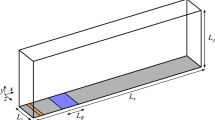Abstract
The maximum distance a hammer can be thrown depends on its mass, length and aerodynamic drag, meaning that record hammer throws performed before and after a rule change (for example, if the minimum mass is changed) cannot be compared directly. However, if all factors affecting the flight of a hammer are fully understood, and the range travelled by a hammer thrown with a given initial speed, angle and release height can be predicted, records thrown under different rules can be compared. In this work, a numerical model is developed, which includes the effects of atmospheric pressure, altitude, Coriolis Effect, gravitational variation, wind speed, ambient temperature, linear drag, torsional drag, hammer size and hammer orientation. It is based on the model of Mizera and Horvath (J Biomech 35:785–796, 2002). Two refinements are made: the drag coefficient varies with Reynolds number, and the hammer is represented as a spatially extended object with nonzero moment of inertia. New wind tunnel data on the drag of the three main components of the hammer (ball, cable and handle) are presented. This data are incorporated into the model which is then used to predict throws made at the IAAF 2011 World Athletics Championships (Daegu, Korea). The model is shown to be capable of predicting to within 1 % the distance of hammer throws where the air density, latitude, release height, release angle and release velocity are known. It is more accurate than numeric and analytic models which assume a constant drag coefficient. This may be because it does not require the user to choose the drag coefficient and automatically uses an appropriate drag coefficient regardless of conditions. With a good biomechanical model or good assumptions about release speeds, throws with different implements can be compared to compare records thrown before and after rule changes. Further work is needed to develop a biomechanical model capable of predicting the release speed an athlete can achieve with a range of different implements.















Similar content being viewed by others
References
Bartonietz K (1994) A biomechanical analysis of throws with different weight and length hammers. Mod Athl Coach 32:33–36
Brice S, Ness K, Rosemond D (2011) An analysis of the relationship between the linear hammer speed and the thrower applied forces during the hammer throw for male and female throwers. Sports Biomech 10:174–184
Clift R, Grace JR, Weber ME (1978) Bubbles, drops and particles. Academic Press Inc, New York
Dapena J (1984) The pattern of hammer speed during a hammer throw and influence of gravity on its fluctuations. J Biomech 17:553–559
Dapena J, Teves M (1982) Influence of the diameter of the hammer head on the distance of a hammer throw. Res Q Exerc Sport 53:78–81
Dapena J, Guthierrez-Davila M, Soto V, Rojas F (2003) Prediction of distance in hammer throwing. J Sports Sci 21:21–28
de Mestre N (1990) The Mathematics of Projectiles in Sport. Cambridge University Press, Cambridge
Gutierrez MSV (2002) A biomechanical analysis of the individual techniques of the hammer throw finalists in the Seville Athletics World Championship 1999. New Stud Athl 17:15–26
Horvath G (2009) Biomechanics: biological applications of mechanics, 3rd edn. Eotvos University Press, Budapest, Hungary, p 368. ISBN 978-963-284-052-9
Hubbard M (1989) The throwing events in track and field. In: Vaughn CL (ed) Biomechanics of sport. CRC Press, Boca Raton, pp 213–238
Isele R, Lee S, Nixdorf E (2012). Biomechanical analysis of the hammer throw at the 2009 IAAF world championships in athletics. http://www.osp-hessen.de: Olympiastutzpunkt Hessen
Janosi I, Bantay P (2002) Statisical test of throwing events on the rotating earth. Eur Phys J B 30:411–415
Mizera F, Horvath G (2002) Influence of environmental factors on shot put and hammer throw range. J Biomech 35:785–796
Acknowledgments
The authors would like to thank Mr Gary Cotton, Mr Graeme Harris and the staff of the Department of Mechanical Engineering’s workshop for help with fabrication of experimental rigs and with the wind tunnel testing. We would like to thank athlete Rick Davidson for performing several test throws which were filmed and analysed during the work.
Author information
Authors and Affiliations
Corresponding author
Rights and permissions
About this article
Cite this article
Jermy, M.C., Burgess, A., Feasey, C. et al. A variable drag coefficient, spatially extended numerical model of hammer throws and new wind tunnel data on current hammers. Sports Eng 17, 151–164 (2014). https://doi.org/10.1007/s12283-014-0150-6
Published:
Issue Date:
DOI: https://doi.org/10.1007/s12283-014-0150-6




